Researchers' Diaries
Clay Bryce
Molluscs and Cruise Leader, Dept. Aquatic Zoology
Kimberley Coastal Survey – Cassini Island and Long Reef, 2010
This 2010 expedition is now complete – except for the specimen curation and writeup. It was a successful trip and like last year, this was due to the extensive amount of trip preparation by all concerned, which dominated the months before departure. From checking that everybody had the correct training and in-date medicals to making sure all the gear was packed and sent to Broome - in short, that everything was ready, checked and rechecked.
Once again a mountain of gear was assembled – it would be nice to travel light for a change! What was new was the inclusion of a satellite dish and its associated gear, which took up an entire pallet… not counting the huge dish! Somehow it seemed to fit on board the Kimberley Quest.
We departed on the afternoon of the 12th October with about 30 hours of steaming time to our first station at Cassini Island. This travel time was spent sorting (and finding) gear, establishing individual work territories and, for some, getting their sea-legs!
We arrived at Cassini Island on the 14th December and immediately began dive operations. Our next job was to assemble the satellite dish and orientate it to receive a signal. Definitely a case of people working out of their comfort zone! We managed to ship the whole affair ashore on a dinghy, haul across a beach and up a sand hill. We set it up on the east side of Cassini Island where it was destined to stay for the duration of the expedition. Periodically, Phil Tucak would go ashore and upload video data he had shot for the website. Visit these videos by clicking on the “Videos” tag on this website.
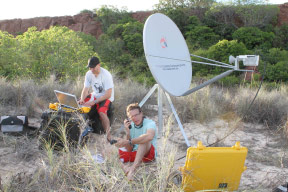
- Cassini Island: Setting up the satellite dish.
- Photo by Merrick Ekins
- Image copyright of WA Museum
Needless to say the trip was a success thanks to careful planning and the professional attitude and expertise of all concerned. Thankfully, no injuries were sustained, no crocs sighted and the sharks stayed away.
Field Participants
WAM = Western Australian Museum, QM = Queensland Museum. AM= Australian Museum, HWA = Herbarium Western Australia (DEC), MV = Museum Victoria
|
Clay Bryce(WAM) |
Molluscs / Cruise leader/ dive supervisor |
|
Merrick Ekins (QM) |
Video habitat mapping & Soft Corals |
|
Sue Morrison (WAM) |
Fishes |
|
Glenn Moore (WAM) |
Fishes |
|
Alison Sampey (WAM) |
Echinoderms |
|
Lexie Walker (AM) |
Polychaetes |
|
Skip Woolley (MV) |
Polychaetes |
|
Monika Schlacher-Hoenlinger (QM) |
Soft Corals |
|
John Huisman (HWA) |
Marine Flora |
|
Lee Betterridge (WAM) |
Crustaceans + general help |
|
Corey Whisson (WAM) |
Molluscs |
|
Andrew Hosie (WAM) |
Crustacea |
|
Zoe Richards (AM) |
Corals |
|
Phil Tucak |
Filming, standby diver and paramedic |
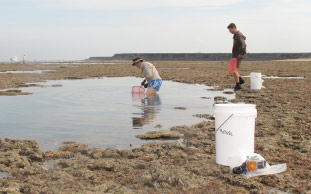
- Station 60 (Cassini I.): Sue Morrison and Glenn Moore collecting fish on the reef platform
- Photo by Clay Bryce
- Image copyright of WA Museum
Survey Locations:
33 stations were sampled across both Cassini Island and Long Reef by the 13 participants using either SCUBA diving or intertidal walks. Each station was sampled for one hour for each of the 8 target taxonomic groups. At each station three transects were laid and videoed for later interpretation and analysis. These replicated transects were then surveyed by the participants and the plants and animals recorded. This process allowed us to count the numbers of organisms of each species in a defined area on the reef and provide abundance data for further analyses.
Cassini Island: this is a small, flat topped (mesa shaped) island in the northern Kimberley. It has a reef platform extending along the western side of the island and a large bay on the east side. This is the first formal marine biological survey of the island. The WA Museum had visited the island, very briefly, in previous years but only on an ad hoc basis. The island’s marine habitats are diverse.
Tides rule in the Kimberley and dictate if and when you can dive or reef walk. As the waters around Long Reef were very turbid much of the diving was restricted to Cassini Island and the relatively cleaner waters on the western side of Long Reef. For Cassini we undertook 16 dives and two intertidal stations (total 18 stations) over an eight day period. Several of the dives were in very shallow water and within the intertidal zone.
The main geomorphic units sampled from seaward to shoreline were:
Fore-reef slope down to 20 m depth – i.e. from the intertidal reef crest down the reef slope.
Reef Platform – both mid and lower littoral.
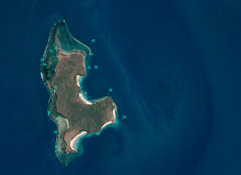
- Cassini Island: Stations visited
- Photo from Google
- Image copyright Google
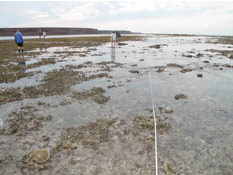
- Cassini I.: Station 59.
- Photo by Clay Bryce
- Image copyright of WA Museum
Long Reef: This survey is the first formal and comprehensive biodiversity survey undertaken at this reef. The WA Museum had visited this reef once before but only sampled at two stations.
Long Reef, as its name indicates is long (over 30 km from end to end) with a central spine of sand. The western side drops off steeply from the reef edge while the eastern side is gently sloping and shallow with very turbid water during spring tides. As such, diving on the east was very limited with only 4 dives conducted. Another 5 dives were completed along the western side and around to the north. Six intertidal stations were also completed.
Long Reef is very similar to Montgomery Reef but less dramatic. It has a for-reef ramp along the western side, albeit very narrow and intermittent, a shallow lagoon and a central spine of sand. In fact, Long Reef may share the same geological history as Montgomery Reef, this is important when considering the uniqueness of these reefs.
The main geomorphic units sampled were:
Fore-reef slope – sloping outer intertidal reef.
Reef terrace – flattened intertidal reef platform extending from the fore-reef ramp back to the shallow lagoon.
Shallow lagoon– contained by a consolidated low ridge. This upper-reef terrace structure should perhaps be considered to be a wide, shallow lagoon.
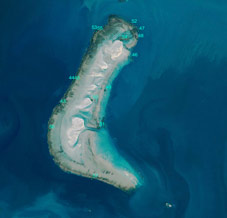
- Long Reef: Stations visited
- Photo from Google
- Image copyright Google
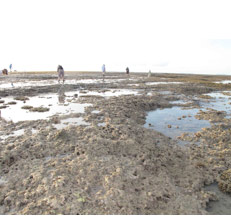
- Long Reef: Station 56; Fore-reef ramp and terrace
- Photo by Clay Bryce
- Image copyright of WA Museum








